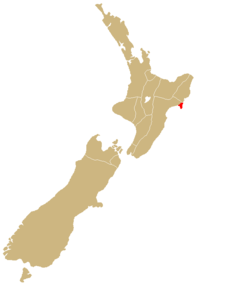Ngāti Rongomaiwahine
| Ngāti Rongomaiwahine | |
| Iwi of New Zealand | |
|---|---|
 | |
| Rohe (region) | Mahia |
| Waka (canoe) | Kurahaupo, Takitimu |
Rongomaiwahine (or Ngāti Rongomaiwahine) is a Māori iwi (tribe) traditionally centred in the Mahia Peninsula on the North Island of New Zealand. In the 2006 census, 4,254 people claimed an affiliation with Rongomaiwahine.[1] In the most recent 2013 census, 4,473 people affiliated with Rongomaiwahine.[2]
The iwi is descended from Rongomaiwahine. She was descended from Ruawharo, the tohunga of the Tākitimu, and Popoto, commander of the Kurahaupō. In Māori traditions, Rongomaiwahine was known to have had two husbands: Tamatakutai and Kahungunu. With Tamatakutai, she bore two daughters, Rapuaiterangi and Hinerauiri. With Kahungunu (well known as the eponymous ancestor of Ngāti Kahungunu) she bore five children: Kahukuranui, Rongomaipapa, Tamateakota, Mahakinui and Tauheikuri.
Historically, Rongomaiwahine have operated successful whaling stations. Today, fishing remains an important industry, along with the operation of sheep and cattle stations. Rongomaiwahine Iwi Trust aka R.I.T is the administrative body of the iwi. There are seven marae affiliated to Rongomaiwahine:[3] Te Apaapa-a-Rangi, Kaiuku, Māhanga, Ruawharo, Te Atihau, Te Rākatō and Tuahuru.
See also
References
- Whaanga, Mere (2006-09-26). "Ngāti Rongomaiwahine". Te Ara – the Encyclopedia of New Zealand. Retrieved 2007-06-29.
- ↑ "2006 Census – QuickStats About Māori (revised)". Statistics New Zealand. 2007-04-04. Archived from the original on 2007-09-28. Retrieved 2007-05-25.
- ↑ "Iwi Profiles (Individual)". www.stats.govt.nz. Retrieved 2016-01-25.
- ↑ "Mahia - Rongomaiwahine". Rongomaiwahine. Retrieved 2016-11-08.
